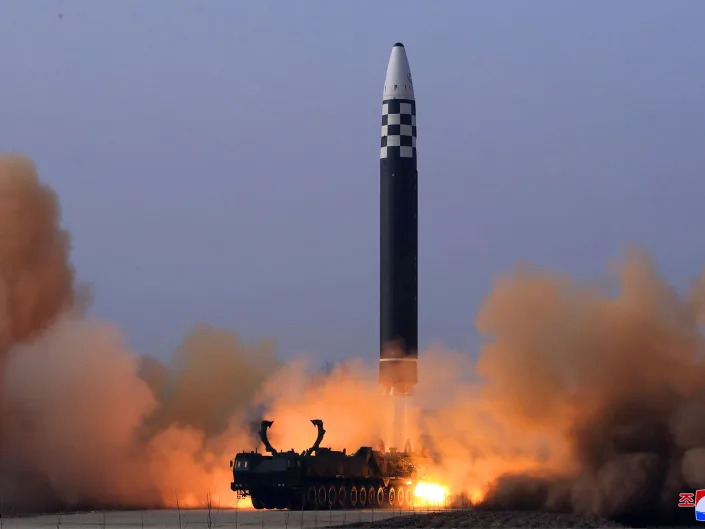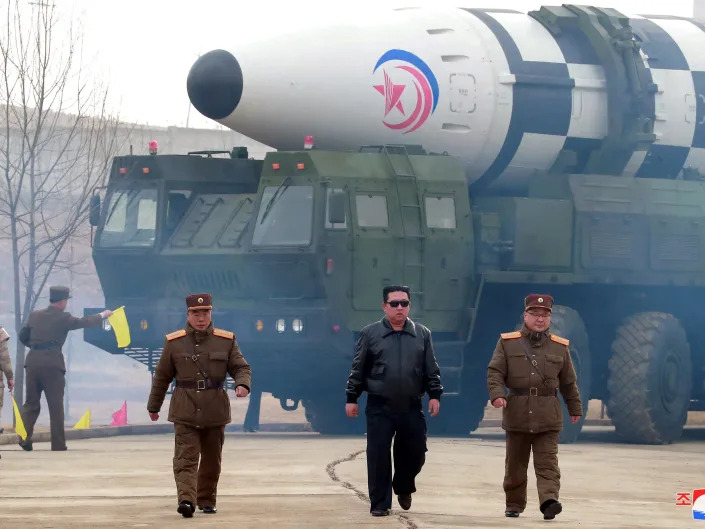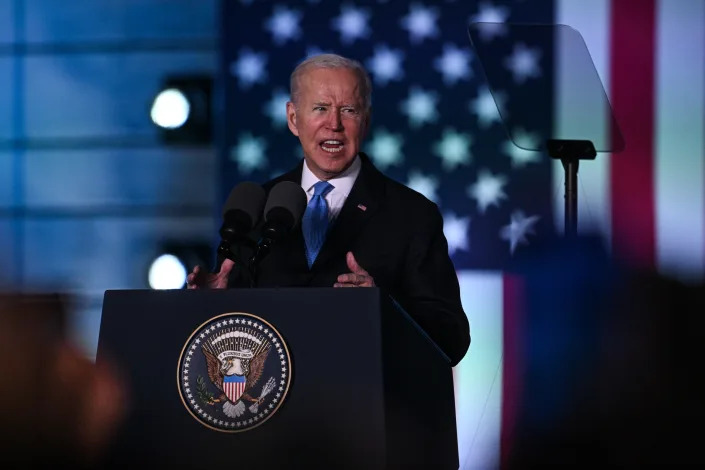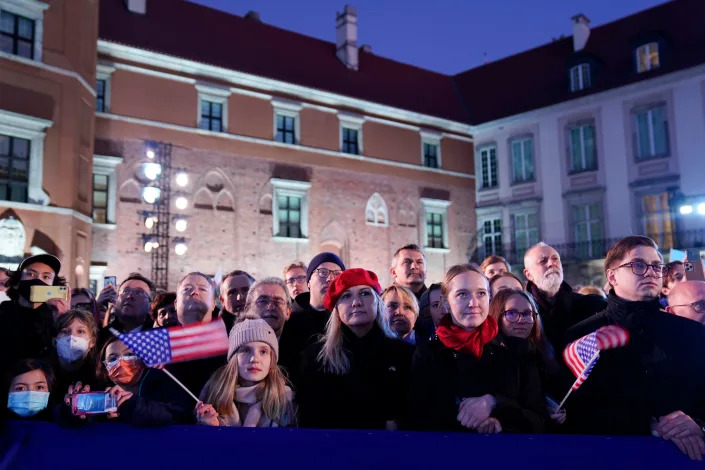SPRING FASHION OUTING WITH KIM
North Korea Hwasong-17 launch gets Hollywood-style effects
By Alistair Coleman
BBC Monitoring
North Korea may have launched its largest intercontinental ballistic missile - and put the world on notice.
But it's the way the news was relayed on state-run television that has caused widespread bafflement.
Instead of triumphant - but staid - tones, this time North Koreans were treated to what they are not supposed to have: a Hollywood-style movie.
It had it all - Kim Jong-un in leather jacket and dark glasses, video effects and dramatic music.
North Korean Central Television usually broadcasts a repetitive diet of Kim family propaganda, alongside military band concerts and feature films about patriotism and feats of labour.
Anything that deviates from this sticks out like a sore thumb.
 EPA
EPAThat's why the coverage of the launch of Hwasong-17 was so different.
Notionally it came in a news bulletin, but the style was anything but.
Viewers were given 15 minutes of video effects, staged drama, and the sight of Kim Jong-un whipping off his dark glasses to look directly into the camera as if to say, "Let's do this".
The stirring music and multiple shots of the missile launch were interspersed with the triumphant tones of veteran newsreader Ri Chun-hee, known in the West as North Korea's "Pink Lady".
Social media users were quick to compare it to Top Gun, Thunderbirds and Bollywood movies.
Some said Kim and his generals walking out of the hangar at Pyongyang's international airport in front of the missile launcher also appeared to mimic the 1983 blockbuster movie The Right Stuff.
So was it meant for North Koreans?
This is all new to North Korean TV viewers. Apart from media smuggled in from abroad - for which those involved risk severe penalties - there has been virtually nothing like this on North Korean screens before.
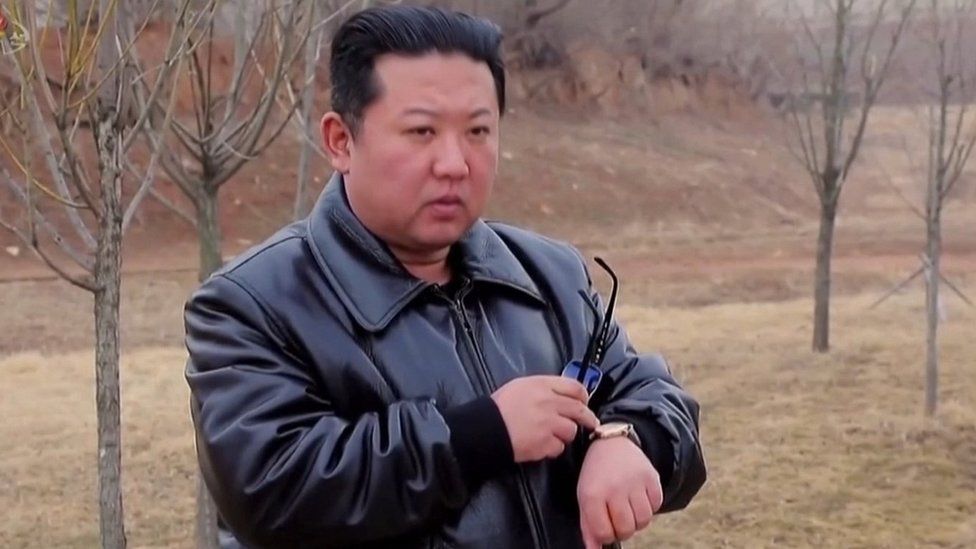 REUTERS
REUTERSIt seems that the country's powerful Propaganda and Agitation Department knew there was a balancing act involved here. They created a video that looks new and exciting to domestic viewers - and thus serves as a boost both to national pride and the image of Kim Jong-un, whose recent weight loss allows for more of a dynamic new all-action personality.
It's a far cry from the last time anything like this was attempted - the Supreme Leader's 2019 ride up sacred Mount Paektu, in which the overweight Kim cut an awkward figure on horseback.
It's impossible to tell what North Koreans watching would have made of it, but it's likely that most would have blinked rapidly - unable to understand the sudden change of tone and colour, not used to such effects. The minority who might have watched a Hollywood movie before may feel confused and ask themselves if this was a mistake, a one-off, or a tantalising sign of change.
As always, the answers may not be forthcoming any time soon.
The people behind North Korea's propaganda also knew that the rocket launch video would be seen and talked about abroad, so perhaps all the effects and Hollywood movie stuff were deliberate - even though to those used to this stuff, the package may appear cliched, and even unintentionally hilarious.
What's the message?
Overall, it's one of total confidence.
IN LEATHER JACKET, AND RAYBANS HIS NAME IS KIM
KIM JONG UN
The missile was launched from Pyongyang Sunan International Airport 25km (16 miles) from the capital. A failure could have been catastrophic for both the airport itself and nearby residents.
Hwasong-17 is a weapon of which Kim Jong-un is intensely proud.
He is delivering a message to the rest of the world - especially the US - that North Korea has the ability to strike anywhere if provoked.
Sending this message in Hollywood style may have been seen in Pyongyang as particularly poignant.
America remains a constant target for Pyongyang's external messaging: While the Ukraine War has barely been mentioned in North Korean media over the last month, when it has, the blame is placed firmly on the US.
 NORTH KOREA STATE MEDIA
NORTH KOREA STATE MEDIA
Carl Samson
Fri, March 25, 2022,
The U.S. has imposed new sanctions on Russian and North Korean entities and individuals over the transfer of sensitive items to Pyongyang’s missile program, the State Department announced on Thursday.
The move was made on the same day North Korea fired its most powerful intercontinental ballistic missile (ICBM) yet — the Hwasong-17 — under the orders of Supreme Leader Kim Jong-un.
First revealed in October 2020, the Hwasong-17 is believed to be not only North Korea’s longest-range weapon, but also the world’s largest road-mobile ICBM to carry nuclear warheads.
During its 67-minute flight on Thursday, the missile reached a maximum altitude of 3,880 miles (approximately 6,244 kilometers) and traveled 680 miles (approximately 1,094 kilometers) before landing in waters between North Korea and Japan, according to the Korean Central News Agency (KCNA), Pyongyang’s official mouthpiece.
The launch marked Pyongyang’s first full ICBM test since 2017 and immediately drew responses from neighbors South Korea and Japan.
Seoul reportedly responded by launching its own missiles from land, sea and air to demonstrate its “capability and willingness to respond immediately and punish.” On the other hand, Tokyo condemned the launch as “outrageous” and “unforgivable” and agreed to strengthen bilateral cooperation with Seoul to counter the threat.
Japanese media also reported that Hwasong-17 could reach the U.S. East Coast if launched on a normal trajectory.
White House Press Secretary Jen Psaki described the launch as a “brazen violation” of U.N. Security Council resolutions and urged Pyongyang to discontinue its actions.
“The United States will take all necessary measures to ensure the security of the American homeland and Republic of Korea and Japanese allies,” she added.
Meanwhile, the U.S. State Department sanctioned the following entities and individuals: Ardis Group of Companies LLC (Russia), PFK Profpodshipnik LLC (Russia), Igor Aleksandrovich Michurin (Russia), the Second Academy of Natural Science Foreign Affairs Bureau (North Korea) and Ri Sung Chol (North Korea).
“These measures are part of our ongoing efforts to impede the DPRK’s [North Korea’s] ability to advance its missile program, and they highlight the negative role Russia plays on the world stage as a proliferator to programs of concern,” said State Department spokesperson Ned Price.
Additionally, the U.S. sanctioned Chinese company Zhengzhou Nanbei Instrument Equipment Co. Ltd. for supplying Syria with equipment from the Australia Group, an informal group of countries that ensures non-export of materials used to develop chemical and biological weapons.
North Korea claims it tested a new ICBM but there's signs they pulled a head fake
North Korea said it launched its largest intercontinental ballistic missile in a test on Thursday.
Experts say footage released by North Korean state media shows the launch may have been faked.
Video posted by North Korean state media showed Kim Jong Un and other military officials observing the launch.
North Korea claims it successfuly launched its largest intercontinental ballistic missile in a test run on Thursday, but there are signs everything is not as it appears.
This was North Korea's first successful ICBM test since Nov. 2017 and the Hwasong-17 is considered the country's largest nuclear-capable missile.
The missile reached an altitude of 3,853 miles and traveled 671 miles during its 71-minute flight before it crashed into Japanese waters, according to reports from South Korean and Japanese officials, NK News first reported. North Korea's KCNA gave a simliar report on the missiles capabilities.
But experts now say footage aired by Korean state media may show the launch was a head-fake. The state TV footage appears to be from an failed test of the Hwasong-17 on March 16, according to a report from NK News, suggesting either North Korea used the wrong footage or the Hwasong-17 wasn't actually launched.
That launch ended when debris from the projectile landed near the North Korean capital, Pyongyang.
"A photo seen by NK News shows a red-tinted ball of smoke at the end of a zig-zagging rocket launch trail in the sky," NK News reported.
A "high-level government official" told South Korea's Yonhap News Agency that officials in Seoul believe its possible the March 24 test was actually of a Hwasong-15 ICBM, an existing missile type first flight-tested in 2017, with enhancements to the engine thrust in order to achieve their desired range.
Regardless of whether or not this test of the Hwasong-17 was real, North Korea's posturing has raised the alarm for South Korea, Japan and the United States.
The White House said Pyongyang must "immediately cease its destabilizing actions" calling the launch a "brazen violation" of strict UN security council resolutions which ban North Korea from testing ballistic missiles — North Korea does not recognize these resolutions as legitimate.
The Japanese foreign minister said the launch is a "clear and serious challenge" to the international community.
Ankit Panda, senior fellow at the Nuclear Policy Program at the Carnegie Endowment on International Peace said this test "presages the start of a more dangerous period on the Korean peninsula."
"There's a fairly simple message with testing of this sort," Panda said in a post on the Carnegie Endowment's Twitter. "It's basically telling the US that nuclear deterrence is a fact of life today and North Korea can hold at risk targets in the United States."
